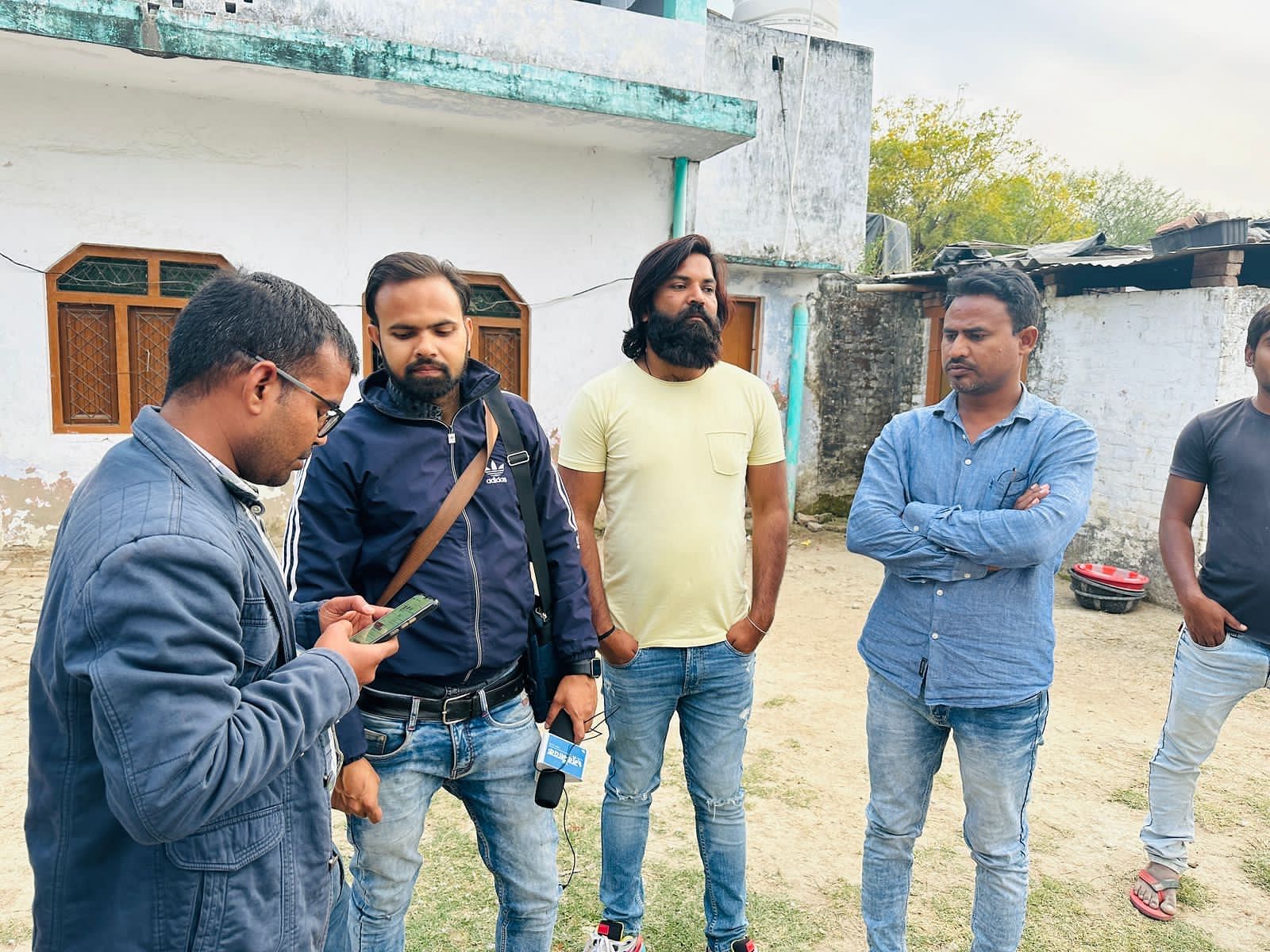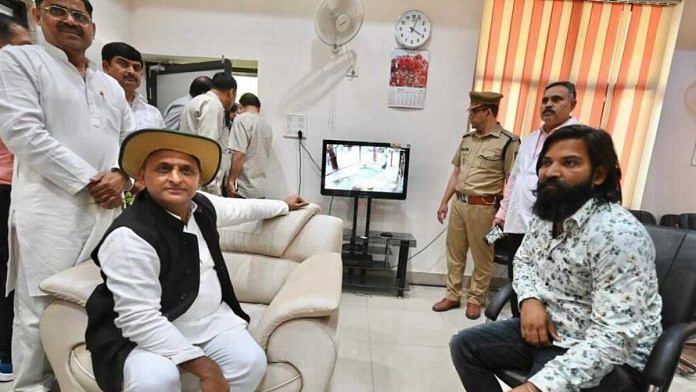Kanpur/Lucknow: Muhammad Arif’s reunion with his beloved sarus crane was not what he expected. The bird that has brought him public and political adulation was visible only through grainy CCTV footage on a television screen that glitched continuously. It was a far cry from the joyful reunion he had hoped for, with the bird leaping about, nipping playfully at Arif as he showers it with kisses. He is certain it misses him more.
This little-over-a-year-old wonderful but disturbing tale of love between a man and a bird has been rudely disrupted by politics, wildlife protection and social media outpouring. Not just the crane, but Arif’s massive fan following on Instagram is missing him too. But policy and politics don’t sit well with either social media fandom or one man’s exotic love.

Even then, there were throngs of people waiting to get a sight of Uttar Pradesh’s new celebrity Arif in Kanpur’s Allen Forest Zoo, accompanied by his sarus crane’s latest well-wisher, Samajwadi Party leader Akhilesh Yadav.
After the sarus was taken away from him on 21 March, to the Samaspur Bird Sanctuary near Raebareli, it escaped. Arif said that he was told by villagers near the sanctuary that the bird didn’t eat for 40 hours. Its adventure ended in a 15-day quarantine, in a 10-foot enclosure in Kanpur. “Does he have Covid?” asked Arif, half-joking, half genuinely bewildered. “He doesn’t have to be brought back to me. He should be free,” he said, upset at hearing that the sarus was caged for 72 hours. Once its quarantine finishes, it will be put into an enclosure that is about 40 feet in length, said the director of the zoo, Dr KK Singh.
Arif sees the bird’s disappearing act as an expression of its loneliness. “He may have been looking for food, but he was also looking for me,” he said. Arif knows their ultimate reunion will be a sight to behold. But the authorities aren’t letting it happen. He travelled to Samaspur, to meet his winged companion and was told by officials he shouldn’t be seen in the area for “at least 24-25 days.”
He was slapped with a notice and called in for questioning by the Uttar Pradesh Forest Department on 2 April. But later Arif was handed another notice, informing him that the official on the case will be occupied with other matters on the day. He is yet to receive another date. Arif has been booked under the Wildlife Protection Act, 1972 for “illegally” keeping and nursing an injured sarus crane.
The minds of animals may be a mystery to most, but Kanpur zoo’s chief veterinarian and deputy director Dr Anurag Singh is firm in his belief that the sarus will recognise Arif, even if they meet in five years.
A group of zoo officials mentioned a worker called Lal Sahab, saying that he too forged a friendship with the sarus. Hearing this, Arif didn’t respond at first but later said, “If my motorbike was here, he’d come with me instantly.”
The commotion surrounding Arif and his ‘dost’ that ended in their separation was kickstarted by his motorbike. The first video to go viral was of Arif zooming on his motorbike, with the sarus a few feet behind, flapping its wings steadily. He had earlier said it travels up to 30-40 kilometres with him, and he is conscious of not going too fast and tiring the bird out.
Living the other’s way of life
Arif and the sarus had both made themselves malleable; compensating for the other’s way of life. The sarus crane, the world’s largest flying bird and Uttar Pradesh’s state bird, is a creature of the wetlands. It is omnivorous, typically eating insects and small aquatic animals.
This particular sarus, Arif said, prefers to eat what he eats. For over a year, it survived on a diet of whatever was cooked in Arif’s house. Dal, vegetables, rotis and eggs had become staples for him. “Once I tried to give him a live fish but he refused,” said Arif. It was perfectly normal for the bird to peck at his plate, and also for Arif to directly feed it.
Consequently, the sarus’ diet has been kept the same in the zoo as well. “We can’t change habits. We’ll have to slowly transition, and switch it over. We’re giving him potatoes and rice and have started giving him greens. Once it finishes 72 hours in the zoo, we’ll start feeding him fish,” said Dr Singh.
Dr Singh is quick to debunk reports that the bird hasn’t been eating, whipping out his phone and showing the sarus pecking about.
The bird still has a callus on its right leg, a scar from the injury that Arif treated.
Sarus, Arif and the media

Arif lives in Mandhka, a village in the Gauriganj tehsil of Amethi, about 26 kilometres from the town. In Gauriganj, wheat is being grown as far as the eye can see –– a sea of insipid brown peppered with some green. At the edges of this green are waterbodies, ponds and marshy wetlands. Sarus cranes often frequent the area.
The sarus crane found itself injured in the fields neighbouring Arif’s. The techniques he used to rehabilitate the bird’s broken leg were the same as he would use for his other animals. His family owns between 10 and 12 hens, a sleepy-eyed rottweiler, a buffalo, and a smattering of goats.
Arif’s family and fellow villagers have adapted—first to the bird and now to the ubiquitous presence of the media. “It didn’t feel strange. I liked it,” said Sadia, a member of Arif’s family, in reference to the bird. “He had become a member of our family,” said his wife.
A local media channel had come to interview Arif. The men of his village gathered behind the camera, listening eagerly and not saying a word.
Mandhka has about 200 residents. On 29 March, Arif returned to his village for the first time since the sarus was taken away by forest department officials. Journalists and media people show up to his house every single day without fail, he said. It has been two months since his videos went viral, and Arif claimed he has given an astonishing 1,300 interviews. “People from all over want to talk to me. BBC, PTI, ANI,” he said, naming a few.
He is ferrying calls all the time, repeating his story time and time again. “I just want to take a day off. I want to switch my phone off and rest,” he said.
Also read: Why was a sarus bonding with UP farmer? Media glorified friendship that shouldn’t have existed
The political scrimmage
Arif is teeming with a combination of pride and bashfulness when he shows a video of him to Akhilesh Yadav. The video appears to be on a British news channel. Yadav watches with a smile on his face, clearly impressed.
Arif and his feathered friend are also at the centre of a political scrimmage. Yadav claims it is after his visit to Mandhka on 5 March that the bird was moved to Samaspur. The order came directly from Chief Minister Yogi Adityanath’s office, he said, adding that an IAS officer was involved too.
The former UP chief minister has assured Arif that his “jurmana” (penalty) will be paid by the Samajwadi Party. If the sarus is not freed and the situation remains unchanged, the party will protest. During his tenure as CM, Yadav had arranged for the protection of sarus cranes, through the Sarus Mitra Scheme. Sarus crane eggs were often attacked by dogs or were stolen. ‘Sarus mitras’ from local communities were given a sum of Rs 500 per month for “looking after” the eggs, said Akhilesh.
Yadav wishes for the bird to be transferred to an area in the state where its kind is found in abundance. It is primarily found in the southwest and central regions of Uttar Pradesh, in Etawah, Aligarh, Etah, Lakhimpur Kheri, Sitapur Shahjahanpur, Barabanki and Hardoi. Yadav names Etawah and Mainpuri as two possibilities.
Arif said he will move wherever the sarus goes. “I’ll take a room nearby,” he said. His wife and children are currently staying with his in-laws, in a village 5 kilometres away from Mandhka. He is unfazed about leaving his family. “It’s how people leave for two-three years to earn money for their families,” comparing his dedication to a vocation of sorts. It is not an unreasonable declaration.
Social media and ticket to politics
Arif has become an Instagram celebrity, a reels darling. A video of the sarus being taken away is shared against the soundtrack of Hum Dil De Chuke Sanam’s (1999) Tadap Tadap song. His hashtag of choice is #arifaursaras and he appeals to his followers constantly, telling them to support and help him with the daunting task of seeing his dost again.
He is acutely aware of the power of social media. He wants to get verified on Instagram and is trying to monetise his YouTube channel. Moreover, he also knows he needs to be able to create content consistently. “Now that he’s gone, what can I do?” Arif asked. As of 29 March, Arif had about 2,40,000 followers. “By the end of the day, it will reach 250 thousand,” he added confidently.
While travelling from Lucknow to Kanpur, Arif was nervous about being recognised. He insisted on tying a scarf around his face while going to the bathroom. At a Samajwadi Party meeting in Kanpur, he was recognised by a cop. “Arif?” the cop asked. At first, Arif looks flustered. But, nonetheless, he participated in a quick selfie session, soon joined by another cop.
In Lucknow as well, he was stopped by a couple of men. This time, he indulged them happily. At the Kanpur zoo, Samajwadi Party workers and Akhilesh Yadav’s supporters had come for Arif too, evident from the way they are shouting his name. He needed to be escorted in, otherwise, he would be swallowed by the crowd.
One of the perils of fame is that it comes with detractors. A man named Shivam Bahrej has claimed that he had nursed a sarus crane since it was a child and had “lost” it, until it was subsequently “stolen” by Arif. He was dismissively called “BJP agent” by Arif.
Arif dresses the part too—tight floral shirts, even tighter ripped jeans, colourful sneakers and aviator sunglasses. A friend of his has just got him trousers from Delhi, with labels like American Eagle and Giorgio Armani. “It’ll be good to wear these in Lucknow,” said Arif, who has been staying in the city for over a week.
Arif watches his own reels on a loop, be it shots of him playing with his ‘dost’ or his appeals to the public. There are videos of ‘fans’ sketching him and the sarus. As the sketch unfolds, Sonu Nigam’s Apne song plays. He told Akhilesh Yadav, “Some of my videos have up to 35 million views.”
Arif has put his life on hold for the bird. Before this, he had fought the gram panchayat elections in Mandhka and lost by 45 votes. His father was also a gram sabha leader. Currently, however, everything hinges on one red-necked and long-beaked creature. His next step? He wants to fight elections on a Samajwadi ticket and knows his ‘dost’ is the key to electoral success.
(Edited by Ratan Priya)






